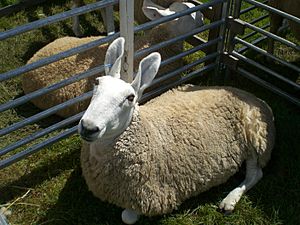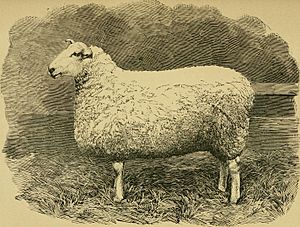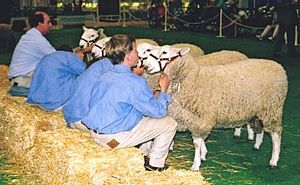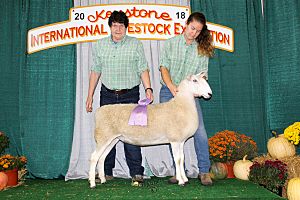Border Leicester facts for kids
The Border Leicester is a special type of sheep that comes from Britain. These sheep are known for being polled, which means they naturally don't have horns. They have long, soft wool and are considered a "dual-purpose" breed. This means farmers raise them for two main reasons: their meat and their wool. Border Leicester sheep are quite large, but they are usually calm and easy to handle. They have become popular around the world and are now found in many countries, including Australia and the United States.
Contents
About Border Leicester Sheep
Border Leicester sheep are quite big. A full-grown male sheep, called a ram, can weigh between 140 and 175 kilograms (about 300-385 pounds). A female sheep, called a ewe, weighs about 90 to 120 kilograms (about 200-265 pounds).
Their wool is white and very long. It's known for being thick and shiny. Spinners, who make yarn from wool, really like Border Leicester wool because it's easy to work with and looks beautiful. Farmers usually shear, or cut the wool off, these sheep twice a year. Each time, the wool can be about 10 centimeters (4 inches) long. Young lambs give about 1.8 kilograms (4 pounds) of wool, while older sheep can give about 3.2 kilograms (7 pounds) at each shearing.
What They Look Like
Border Leicester sheep are always white. They have a long body, a strong chest, and a wide, sturdy back. Their noses should be black, and their ears are large, stand up straight, and look alert. Their feet are also dark. Their heads and legs don't have wool; instead, they are covered in short, white hair. This makes it easier to shear them. A special feature of this breed is their "Roman nose," which means their nose has a distinct bump, similar to the North Country Cheviot sheep.
Why Farmers Like Them
Border Leicester sheep have many good qualities that make them great for farmers.
- Good Mothers: They are known for being excellent mothers and take good care of their lambs. They also produce plenty of milk for their babies.
- Fast Growers: Their lambs grow quickly, which means they are ready for market sooner. They produce high-quality meat that is popular.
- Easy to Manage: This breed is strong and healthy. They are generally easy to keep and manage on a farm.
History of the Breed
The Border Leicester sheep breed first started in 1767 in Northumberland, England. This area is close to the border with Scotland, which is how the sheep got the "Border" part of their name. Their ancestors were a type of sheep called "Dishley Leicester" rams.
A famous farmer named Robert Bakewell (who lived from 1726 to 1795) created the Dishley Leicester breed. He crossed old sheep from Lincolnshire with sheep from Leicestershire. His Dishley Leicester sheep became very popular with farmers.
Two brothers, George and Mathew Culley, bought some of Bakewell's Dishley Leicesters. They sold these sheep, and soon the breed was found on both sides of the English-Scottish border.
Around the 1830s, two slightly different types of Dishley Leicesters began to appear. The Culley brothers were crossing their sheep with Teeswater sheep. Other farmers in different areas along the border were crossing their sheep with Cheviot sheep. These differences led to the two types being nicknamed "Bluecaps" and "Redlegs." Many farmers preferred the "Redlegs" because they were tougher. By about 1850, this tougher version of the Dishley Leicester became known as the Border Leicester. By the 1800s, they were a common breed in the UK.
Around the World
Today, you can find registered groups of Border Leicester sheep in England, Ireland, Scotland, and Wales. They have also been sent to many other countries, including Canada, China, France, South Africa, the United States, and Japan.
Border Leicester sheep first arrived in Australia in 1871. Now, there are many large groups of them there. In Australia, Border Leicester rams are often bred with Merino ewes. This creates a special "first-cross" ewe that is very good for raising lambs for meat. These crossbred ewes are known for having good bodies, being able to have many lambs, finding food well, and producing plenty of milk.
These Border Leicester-Merino cross ewes are then often bred with other types of rams, like Poll Dorset or Southdown rams. This creates "prime lambs" that grow quickly and have the perfect shape for meat. Most of the lambs raised for meat in Australia are bred this way.
Border Leicester sheep also contributed about half of the genes to another Australian sheep breed called the Gromark.
The breed was brought to New Zealand in 1859. After refrigeration became common in the 1880s, Border Leicesters were used to create large lambs and mutton (meat from older sheep). They also helped develop new New Zealand breeds like the Coopworth and the Borderdale.
In the United States, the first group for Border Leicester breeders was formed in 1888. Today, there are two main groups for breeders. Farmers show their Border Leicester sheep at local fairs and larger shows throughout the year. A big national show is held every November in Louisville, Kentucky.
See also
 In Spanish: Border Leicester (oveja) para niños
In Spanish: Border Leicester (oveja) para niños





